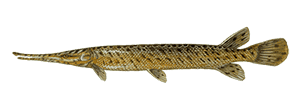Spotted Gar

Species Details
Lepisosteus Oculatus
Lepisosteidae
Lepisosteiformes
Creeks, Rivers, Lakes, Brackish Water
4 - 6 lbs.
15" - 59"
Spotted Gar (Lepisosteus oculatus) Fish Description
With its long streamlined body, long snout, and prominent rows of teeth, the Spotted Gar (Lepisosteus oculatus) can be an intimidating sight, especially for a novice angler. As the name implies, its body is covered with dark spots. Its body is mostly olive or brownish in color on top from the head to the tail base but lightens a bit at the belly. Its body is also covered with hard, diamond-shaped scales called ganoids that protect the fish from predators, which are not actually that many except for other gar species.
The Spotted Gar is known as a voracious predator that hunts for food mostly at night. During the day, it remains stationary near fallen trees or brush. It preys mainly on crayfish, crabs, and other aquatic crustaceans. Nonetheless, it will still eat other fishes including bass, shiners, catfish, and even those larger than itself given the opportunity. It uses its coloration as camouflage as it lays still on soft, muddy bottoms and ambush unsuspecting victims. It can at times even wander in brackish waters in search of food.
Aside from its menacing appearance, one other feature that makes this fish unique is its specialized bladder that gives the fish the ability to survive in waters with low oxygen concentrations. This allows the Spotted Gar to adapt and inhabit streams, swamps, and other backwaters that are poorly oxygenated.
Interesting Facts About Spotted Gars
- The world record for biggest Spotted Gar measured a little over forty-one inches and weighs twelve pounds.
- The lucky angler who caught the world record Spotted Gar is Jerrime Tucker of Conway, Arkansas while bowfishing with a friend in Lake Conway.
- The females are mostly bigger than males.
- Spotted Gar spawning starts in February and ends in June.
- They move to the shallow parts of the water with healthy vegetation during spawning season.
- Their fertilized eggs are sticky and attach to aquatic plants until they hatch.
- Their youngs mostly feed on mosquito larvae and small crustaceans.
- The freshwater fish has a long lifespan of about 18 years.
- As voracious predators, they play an essential role in their ecosystem’s balance.
- They are a primitive fish that exist that is said to have existed since the time of the dinosaurs.
- They are rarely caught for food.
- Its eggs or roes are highly toxic to humans.
- They are sometimes considered a nuisance for anglers targeting other fishes as this fish is known to attack and compete for hooked fishes.
Spotted Gar Average Size and Swimming Speed
Although they can swim a bit faster in short bursts if need be, Spotted Gars are not known to be fast swimmers. Most Gars are known to be slow swimmers. Unlike the Alligator Gar that can grow really big, average size of the Spotted Gar tends to be around twenty to thirty inches long.
Spotted Gar Habitat and Distribution
Like most gar species, the Spotted Gar prefers to swim around calm, clear pools and bays with plenty of water vegetations. It is usually found in lakes and swamps with soft mud bottoms where it hunts at night. During the day, they are often found near the surface resting near fallen logs, trees, or brush. As spawning season comes, adults tend to move to the shallow parts of the water of up to six to fifteen feet deep, again with lots of aquatic plants where they are known to lay their eggs.
You can find plenty of these fish in the Great lakes as well as in Mississippi River drainages, and river drainages along the northern coast of the Gulf of Mexico—from the Nueces River in Texas to the lower Apalachicola River in Florida. It can also be found in the north and south shores of Lake Erie in northern Ohio, Michigan, and Ontario.
Spotted Gar Fishing Tips
Spotted Gars are said to be fairly easy to hook whatever bait you’re going to use given their rather voracious eating tendency. But keep in mind that they can sometimes be a bit hard to land given their tenacious fighting spirit. Make sure that you’re equipped 6 foot spinning rod with a good quality reel with enough line to be able to handle the fish. A 14 to 30 pound braided line should be enough. You might also need a landing net to make it easier for you to land or bring the fish aboard your boat.







